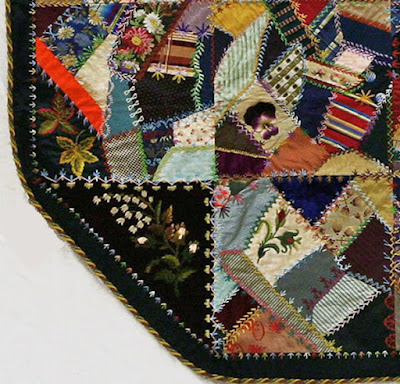I've spent a lot of time lately looking closely at these fancy,
embroidered crazy quilts from the 1880-1900 period. This one was
recorded by the Kent County, Maryland project.
I am especially interested in those with passementerie-style edges (military braids, cords & tassels, etc.) Most I've found seem to have been made in the bluegrass region of Kentucky: near Louisville & Lexington.
Or in Missouri
St. Joseph about the time the Civil War began
Mother Sarah may have had a hand in the quilt too. Her Civil War experiences as a young mother with several children give us a picture of the war in Missouri. Sarah, born in Maryland, married Enos, the local school teacher who came from New Jersey to Kent County. After several years in Chestertown "the western fever smote them," according to an obituary of Enos and they moved to St. Joseph just before the war in 1860.
St. Joe was a jumping off place for overland travelers to the west coast.
This 1859 Albert Bierstadt photo shows a party waiting for
a ferry to cross the Missouri River.
Like most of Missouri St. Joseph had divided loyalties during the war. About two thousand local soldiers fought on the Union side; the same amount on the Confederate. The town see-sawed between Union and Confederate control in the first year. Tensions had been apparent before the war, due to the proximity of Kansas and it's free-state/slave-state struggle. By early1861 Northern-born travelers were avoiding St. Joe, supplying their wagons in Council Bluffs, Iowa, as explained by Mr. Wardell in a letter published a few weeks before Fort Sumter.
In December, he reported "several big men" threatened to "turn out any time, to mob any Northern man who came through Missouri in the spring....Slayback, Jackson, Jeff Thompson, Montgomery" and several others.
Meriwether Jeff Thompson (1826-1876)
Virginia-born Jeff Thompson was the city's pre-war mayor. In 1905 Robert C. Bradshaw recalled a local incident that made national news in 1861.
"Lowering the flag to a mob..." from J.M. Bassett's 1864
book Union Men and Their Sufferings in North-Western Missouri
"I saw M. Jeff Thompson and others tearing into shreds the United States flag which had just been torn from the flag staff of the Post-Office building... a few minutes fully five hundred men had assembled. When the cry was raised, 'Now for the dirty rag on Turner Hall.' Hearing this, I hastened to Turner Hall...When forty feet from the Hall [the mob] they were halted by M. Jeff Thompson. Then Alonzo W. Slayback and Thomas Thourghman (both well-known to me) came forward, and in the name of peace...asked me to take the flag down, saying that Jeff Thompson was drunk and no one could tell what a 'mob' under a drunken leader would do. I declined to comply with their request."
Collection State Historical Society of Missouri
The Paw-Paw Militia headed by Odon Guitar was a Union militia,
here drilling with broomsticks on the streets of St. Joseph in 1863.
At the end of the year St. Joseph was placed under Union martial law for the rest of the war. Son Charles Francis Bacon (1856-1936), told a newspaper reporter years later that the Bacons were:
" 'Southern sympathizers' and Southerners found the climate pretty warm in St. Joseph at times during the hostilities [but] they never had any very serious clashes with the few Union forces...nor with the 'bushwhackers,' more numerous and infinitely more bothersome."
Alexander Bacon enlisted in the U.S. Colored Troops in 1863
During the war Enos apparently enlisted in a militia unit (Union or Confederate?) despite his "frail constitution." One night during a storm when he was assigned to guard a store of gunpowder, he decided the weather was more than he could brave so he walked home up Jule Street. He was court martialed but acquitted on account of the weather (!)
Post-war St. Joseph
The crazy quilt, stitched abut 20 years after the war, was made by the girls while living at the Bacon House. The hotel thrived and they were probably affluent enough to buy machine-embroidered swatches to attach among all their hand-worked stitches.
Why the corded edge so typical of Kentucky? Perhaps one or more of the girls went to school in Kentucky, a likely passage for Missouri's upper-class Southern-born girls. Or a Kentuckian might have come to St. Joseph to teach needlework in that elegant style.
After father Enos died in 1895 Sarah and son Charles ran the hotel. She apparently had always had a hand in the management (and law suits.)
Here in 1896 she's had a boarder in a neighboring hotel arrested
for disturbing her customers with his barking dogs.
But the Bacon House was soon bankrupt (the 1890s a hard time for businesses.)
The girls
Sarah Ewing Bacon became Sallie G. Hickock who lived in Portland, Oregon. Anna was Mary Anna Bacon who remained unmarried in St. Joseph and Rachel the youngest became Rachel Baker of Alberta, Canada.
The elder Sarah Bacon died in 1905 at 77. By then she was living in Portland with daughter Sarah Bacon Hickock.























2 comments:
The history in 1 quilt - it always amazes me what you come up with. Much appreciated.
Lady Locust
Lady L---that's why I love writing about quilts. They are one thing women left and with a little research one can find so many untold stories.
Post a Comment